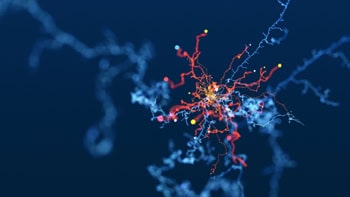Join the audience for a live webinar at 1pm GMT/2pm CET/8am EST on 7 November 2024 to explore the knowns and unknowns of negative triangularity and evaluate its future as a power plant solution
The webinar is directly linked with a special issue of Plasma Physics and Controlled Fusion on Advances in the Physics Basis of Negative Triangularity Tokamaks; featuring contributions from all of the speakers, and many more papers from the leading groups researching this fascinating topic.
Want to take part in this webinar?

In recent years the fusion community has begun to focus on the practical engineering of tokamak power plants. From this, it became clear that the power exhaust problem, extracting the energy produced by fusion without melting the plasma-facing components, is just as important and challenging as plasma confinement. To these ends, negative triangularity plasma shaping holds unique promise.
Conceptually, negative triangularity is simple. Take the standard positive triangularity plasma shape, ubiquitous among tokamaks, and flip it so that the triangle points inwards. By virtue of this change in shape, negative triangularity plasmas have been experimentally observed to dramatically improve energy confinement, sometimes by more than a factor of two. Simultaneously, the plasma shape is also found to robustly prevent the transition to the improved confinement regime H-mode. While this may initially seem a drawback, the confinement improvement can enable negative triangularity to still achieve similar confinement to a positive triangularity H-mode. In this way, it robustly avoids the typical difficulties of H-mode: damaging edge localized modes (ELMs) and the narrow scrape-off layer (SOL) width. This is the promise of negative triangularity, an elegant and simple path to alleviating power exhaust while preserving plasma confinement.
The biggest deficiency is currently uncertainty. No tokamak in the world is designed to create negative triangularity plasmas and it has received a fraction of the theory community’s attention. In this webinar, through both theory and experiment, we will explore the knowns and unknowns of negative triangularity and evaluate its future as a power plant solution.
Want to take part in this webinar?

Justin Ball (chair) is a research scientist at the Swiss Plasma Center at EPFL in Lausanne, Switzerland. He earned his Masters from MIT in 2013 and his PhD in 2016 at Oxford University studying the effects of plasma shaping in tokamaks, for which he was awarded the European Plasma Physics PhD Award. In 2019, he and Jason Parisi published the popular science book, The Future of Fusion Energy. Currently, Justin is the principal investigator of the EUROfusion TSVV 2 project, a ten-person team evaluating the reactor prospects of negative triangularity using theory and simulation.
Alessandro Balestri is a PhD student at the Swiss Plasma Center (SPC) located within the École Polytechnique Fédérale de Lausanne (EPFL). His research focuses on using experiments and gyrokinetic simulations to achieve a deep understanding on how negative triangularity reduces turbulent transport in tokamak plasmas and how this beneficial effect can be optimized in view of a fusion power plant. He received his Bachelor and Master degrees in physics at the University of Milano-Bicocca where he carried out a thesis on the first gyrokinetic simulations for the negative triangularity option of the novel Divertor Tokamak Test facility.
Andrew “Oak” Nelson is an associate research scientist with Columbia University where he specializes in negative triangularity (NT) experiments and reactor design. Oak received his PhD in plasma physics from Princeton University in 2021 for work on the H-mode pedestal in DIII-D and has since dedicated his career to uncovering mechanisms to mitigate the power-handling needs faced by tokamak fusion pilot plants. Oak is an expert in the edge regions of NT plasmas and one of the co-leaders of the EU-US Joint Task Force on Negative Triangularity Plasmas. In addition to NT work, Oak consults regularly on various physics topics for Commonwealth Fusion Systems and heads several fusion-outreach efforts.
Tim Happel is the head of the Plasma Dynamics Division at the Max Planck Institute for Plasma Physics in Garching near Munich. His research centres around turbulence and tokamak operational modes with enhanced energy confinement. He is particularly interested in the physics of the Improved Energy Confinement Mode (I-Mode) and plasmas with negative triangularity. During his PhD, which he received in 2010 from the University Carlos III in Madrid, he developed a Doppler backscattering system for the investigation of plasma flows and their interaction with turbulent structures. For this work, he was awarded the Itoh Prize for Plasma Turbulence.
Haley Wilson is a PhD candidate studying plasma physics at Columbia University. Her main research interest is the integrated modelling of reactor-class tokamak core scenarios, with a focus on highly radiative, negative triangularity scenarios. The core modelling of MANTA is her first published work in this area, but her most recent manuscript submission expands the MANTA study to a broader operational space. She was recently selected for an Office of Science Graduate Student Research award, to work with Oak Ridge National Laboratory on whole device modelling of negative triangularity tokamaks using the FREDA framework.
Olivier Sauter obtained his PhD at CRPP-EPFL, Lausanne, Switzerland in 1992, followed by post-doc at General Atomics in 1992-93 and ITER-San Diego (1995/96), leading to the bootstrap current coefficients and experimental studies on Neoclassical tearing modes. He has been JET Task Force Leader, Eurofusion Research Topic Coordinator and recipient of the 2013 John Dawson Award for excellence in plasma physics research and nominated since 2016 as ITER Scientist Fellow in the area of integrated modelling. He is a senior scientist at SPC-EPFL, supervising several PhD theses, and active with AUG, DIII-D, JET, TCV, WEST focusing on real-time simulations and negative triangularity plasmas.
About this journal

Plasma Physics and Controlled Fusion is a monthly publication dedicated to the dissemination of original results on all aspects of plasma physics and associated science and technology.
Editor-in-chief: Jonathan Graves University of York, UK and EPFL, Switzerland.



